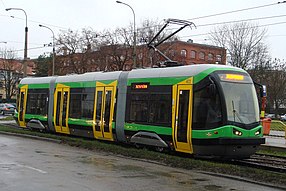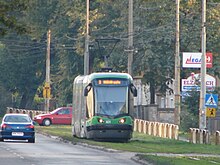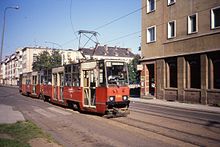Elbląg tram
| Elbląg tram | |
|---|---|
| PESA 121N car on Robotniczej Street | |
| Basic information | |
| Country | Poland |
| city | Elbląg |
| opening | November 23, 1895 |
| operator | ZKM Elbląg |
| Infrastructure | |
| Route length | 15 km |
| Track length | 32 km |
| Gauge | 1000 mm ( meter gauge ) |
| Power system | 600 volt DC overhead line |
| Operating mode | Furnishing operation |
| business | |
| Lines | 5 |
| vehicles | 42 |
| Network plan 2008 | |

The Elbląg tram is the tram system in the Polish city of Elbląg ( German Elbing ) near the Baltic Sea coast. It is operated by the municipal company Tramwaje Elbląskie. Elbląg has the second oldest electric tram network in Poland after Wroclaw . Its history goes back to 1895.
The tram network is used by 5 lines, one of which only runs on weekdays. The track width of the rails is 1000 millimeters ( meter gauge ), the track length is 32 kilometers. The trains run according to an approximate timetable.
history
In the 19th century, the then rapidly growing German city of Elbing needed modern local public transport, which is why the city council decided in 1895 to build the first two tram routes, which were to connect the residential areas with the center, the train stations and the up-and-coming industrial companies. In the following years the tram network is systematically expanded. The Elbingen tram chose the meter gauge, which is unusual for today's Poland. This can now only be found on the Bydgoszcz , Łódź , Toruń and Grudziądz trams .
At the end of the Second World War , the Polish authorities decided to rebuild the damaged infrastructure. As early as 1946, operations could be resumed on the first two lines. Line 3 followed a year later. In 1957, the Konstal 5N and 5ND trams brought the first new vehicles to Elbląg. At the moment there is still a 5N + 5ND traction (car numbers 012 and 154) in operation, which runs on special occasions. At the beginning of the 1970s, the People's Republic of Poland decided to shut down meter-gauge tram networks in most Polish cities. This should also be done in Elbląg. However, the Elbląg tram did not share the fate of the trams in Bielsko-Biała , Legnica and Olsztyn . The use of new Konstal 805Na vehicles began in 1980 and are still in use today. In 1986 a new line was put into operation in the Zawada district.
As a result of the political changes in Poland, as in other Polish cities, there was also a decline in the number of passengers in public transport in Elbląg. At the beginning of 1987, the old Konstal 5N cars were replaced by younger used vehicles from Germany of the Duewag GT6 type . It was not until the beginning of the 21st century and when Poland joined the European Union that the city of Elbląg began to invest in environmentally friendly public transport. Thanks to the EU-Fons, the rail network was renewed and new lines built. In 2002, a new line was opened on Pułkownik Dąbka Street, which is served by two new lines (4 and 5). Big changes are imminent in the near future. By 2013, 15 kilometers of track are to be renewed and new low-floor railcars procured. The first six PESA 121N vehicles from PESA Bydgoszcz were delivered at the end of 2006. As far as possible, the modernized Konstal 805Na should replace the German Duewag GT6 and complement the low-floor wagons.
In May 2006, the construction of a stretch in the direction of Fromborska Street to the Nad Jarem settlement began. On December 21, the section was officially inaugurated together with the presentation of the new low-floor trams. In the period that followed, the PESA 121N derailed several times in accidents. The procurement of two more low-floor wagons is planned for the coming years.
timeline
- November 22, 1895: Opening of the first two tram lines. Line 1: Train station - Holländer Chaussee - Johannisstrasse - Innerer Mühlendamm - Friedrich-Wilhelm-Platz - Schmiedestrasse - Alter Markt - Hinterstrasse - river port on Elbing . Line 2: Friedrich-Wilhelm-Platz - Schmiedestraße - Alter Markt - Markttorstraße - Schichaustraße - Königsberger Straße - crossing Hochstraße / Galgenberg
- May 22, 1897: Line 3 opened: Alter Markt - Schichaustraße - Königsberger Straße - Lönsallee - Fasanerie and extension of Line 2 to the train station
- 1901–1905: Expansion of the depot on Hospitalstrasse
- May 29, 1916: Kaiser Wilhelm II takes the tram from the train station to the Schichau works
- 1927: The route to Paulikirchstrasse and Mackensenstrasse goes into operation
- 1928: Opening of the second depot on Kastanienallee
- June 1, 1946: resumption of tram traffic after the war on line 1 (station - Grunwaldzka - 3 Maja - 1 Maja - pl.Słowiański - Kowalska - Stary Rynek - Brama Targowa - Stoczniowa - Robotnicza - Browarna - Obrońców Pokoju)
- November 1, 1946: resumption of tram traffic after the war on line 2 (Bażantarnia - Marymoncka - Królewiecka - Stoczniowa - Brama Targowa - Stary Rynek - Kowalska - 1 Maja - grobla św. Jerzego - Bema / Mickiewicza junction)
- April 3, 1947: Line 3 opened (Plac Słowiański - 1 Maja - Traugutta - Górnośląska - Agrykola Cemetery)
- February 15, 1951: Commissioning of a new line from the train station to Druskiej Street
- 1955: Construction of reversible loops on Ulica Druska and Ulica Obrońców Pokoju (previously there were stump ends.)
- 1955: Construction of the turning loop on Ulica Saperów (with extension of the route from the Bema / Mickiewicza intersection)
- 1956: Construction of the turning loop at Bażantarnia Park (with a short walk to the bridge over the Kumi River)
- 1957: Construction of the second track on Ulica Grunwaldzka
- 1957: first delivery of type 5N and 5ND cars
- 1967: Line 3 to Agrykola cemetery closed
- 1968: The tram is banished from the old town and relocated to Ulica Pocztową
- April 15, 1980: the first two 805Na railways operate in Elbląg
- November 24, 1986: Extension of the route from Ulica Obrońców Pokoju to the Zawada settlement and opening of the new line 3 (Saperów - Ogólna)
- 1995: Centenary of the Elbląg tram
- December 12, 1996: last day of operation of the 5N and 5ND
- January 1997: the first used GT6 from Germany go into passenger service
- August 31, 2002: Opening of the new double-track line on Ulica Pułkownik Dąbka (from Plac Jagiellończyka to Ulica Obrońców Pokoju) and opening of lines 4 and 5
- December 21, 2006: Opening of the double-track section on Ulica Ogólna (up to the intersection with Ulica Legionów), in preparation for the use of low-floor wagons
- August 19, 2010: Commissioning of the new line at Plac Konstytucji and Ulica Generała Grota-Roweckiego (together with the branch towards Ulica 12 Lutego), simultaneous closure of the line in a section of Ulica Grobla Świętego Jerzego
- April 1, 2012: In connection with the track renewal in Ulica Pocztowa, the tram service there was interrupted. In the south, a bus replacement service was set up with the lines T3 and T4, in the north the tram lines 200 (Depot - Marymoncka), 300 and 400 (Depot - Ogólna)
- October 9, 2012: Line 300 was closed due to the track renewal on Ulica Browarna.
Planned investments
Integrated public transport development program from 2004 to 2013
- New construction of a double-track line on Ulica 12 Lutego: from the intersection with Ulica Tatralna, Nowowiejska and Królewiecka to Ulica Grota-Roweckiego and along Ulica Grota-Roweckiego
- Construction of a new double-track line along Ulica Fromborska (from Ulica Ogólna) and along Ulica Królewiecka (from Ulica Fromborska to the intersection of Marymoncka / Piłsudskiego)
- New construction of a double-track line along the Aleja Odrodzenia up to a loop at the level of Ulica Mazurska
Further planning
- New line from Plac Słowiański along Ulica Rycerska and Aleja Tysiąclecia to Plac Grunwaldzki
- New line to the Modrzewina urban development area along Aleja Jana Pawła II to a loop at the end of the street
- Construction of a new tram depot on Ulica Fromborska
Line network (as of 2012)
line 1
|
Line 2
|
Line 3
|
Line 4
|
Line 5
|
Loops and Terminals
Reversible grinding
The Elbląg tram runs with one-way vehicles, so there are reversing loops at all terminals .
| loop | Installation | Shutdown | Tracks | further infrastructure | Lines |
|---|---|---|---|---|---|
| Druska (old) |
1955
|
2006
|
1
|
siding | - |
| Druska (new) |
2006
|
3
|
1,2,4 | ||
| Marymoncka |
1956
|
1
|
two sidings | 2 | |
| Obrońców Pokoju |
1955
|
1
|
unused | ||
| Ogólna |
1986
|
2006
|
2
|
siding | - |
| Ogólna (Nad Jarem) |
2006
|
3
|
1,3,4,5 | ||
| Saperów |
1955
|
2
|
3.5 |
Further terminals
- The only terminal that does not have a loop is at the depot on Ulica Browarna at the level of Ulica Jaśminowa. It is a turning triangle that used to be the entrance to the depot. After building a new entrance to the depot, the triangle remained. It is used for track construction work, accidents and longer closures, as well as when the network is disconnected.
- Until the beginning of 1956, only two-way cars operated on the Elbląg tram network, which is why there were no reversing loops until the 1950s. With the use of the new Polish Konstal 5N wagons, loops had to be built successively at the end points. Individual sections were also shut down when there was no space for a turning loop. Among other things, this affected the route to the Bażantarnia Park, which was shortened by 700 meters. The lines on Ulica Traugutta and Ulica Agrykola have been completely closed.
vehicles
Vehicles in regular service
All information relates to the status Jan. 1, 2015
| image | Type | Start of the mission | number | |
|---|---|---|---|---|
 |
MAN M8C | 2013 | 3 | |
 |
Konstal 805Na | 1980 | 19th | |
 |
Düwag GT6 | 1996 | 0 | |
 |
PESA 121N | 2006 | 6th | |
| Total number | 28 | |||
| Share of low-floor wagons | 29% | |||
| Average age of vehicles | 19 years | |||
Web links
- Official website of the operator ZKM Elbląg (Polish)
- Tram Elbląg on UrbanRail.Net (English)
- Private website about the Elbląg tram (Polish)







